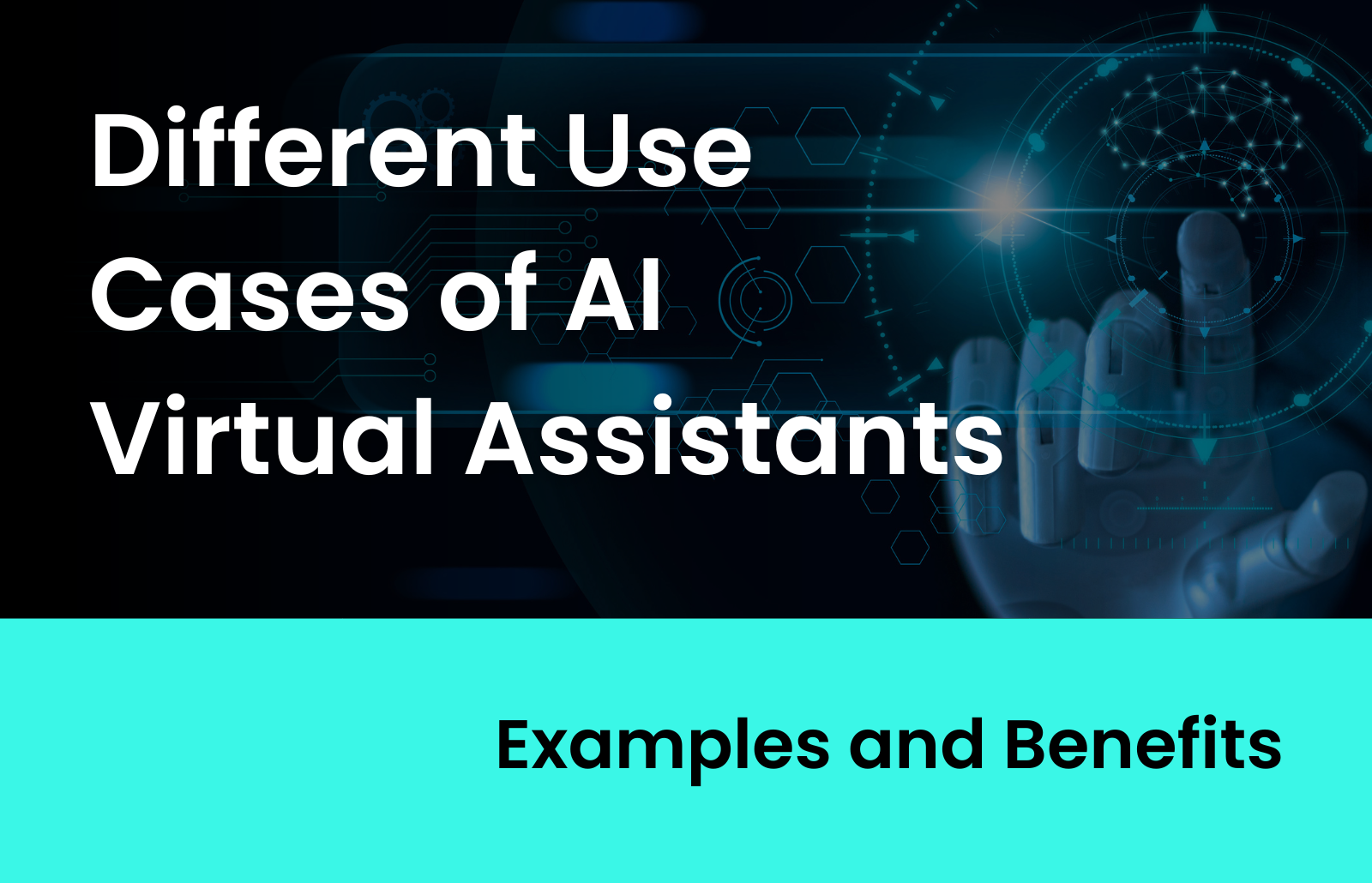Are you ready to embrace the power of AI and unlock a world of enhanced productivity and streamlined workflows? Estimates of the global AI virtual assistant or chatbot market size differ significantly, ranging from as low as $100 million to over $5 billion. Statista’s projected figure for 2027 stands at $455 million, derived from market values in 2018 and expected compound annual growth rates (CAGR). Notably, the most rapid growth in the chatbot market is observed in East Asia.
AI virtual assistants (AI VA s), also known as AI-powered virtual assistants, virtual assistant AIs, or AI chatbots, are rapidly transforming how we interact with technology and manage tasks. These intelligent systems leverage natural language processing (NLP) to understand and respond to human requests, automating processes and streamlining workflows.
This blog post delves into the diverse use cases of AI VAs, showcasing their potential to revolutionise various aspects of business and personal life. We’ll explore specific examples and highlight the benefits these virtual assistants offer across industries.
Business Intelligence: Unlocking Data-Driven Decisions
Business Intelligence (BI): BI refers to the practices, tools, and technologies used to gather, analyse, and interpret data to gain insights that can inform business decisions. Traditionally, BI tools required some level of technical expertise to use.
AI Virtual Assistant: AI virtual assistants, also known as chatbots or virtual assistant AIs, are computer programs that leverage AI and natural language processing (NLP) to understand and respond to user queries conversationally. These assistants can be integrated into various platforms, from websites to mobile apps to smart devices.
Now, how do these two come together?
- Unlocking Data with AI: Traditionally, BI systems might not have been readily accessible to everyone in a company due to technical barriers. AI virtual assistants bridge this gap by acting as an intermediary between users and BI tools. Users can ask the AI assistant questions in natural language, and the assistant can access and interpret relevant data from BI systems, providing insights in an easy-to-understand way.
- Data-Driven Decisions: By making BI data more accessible and user-friendly through AI virtual assistants, businesses empower employees at all levels to make data-driven decisions. This can lead to improved efficiency, cost savings, and better outcomes across various departments.
Customer Service: Personalised Experiences at Scale
AI VAs are reshaping the landscape of customer service, offering personalised experiences on a scale previously unimaginable.
i) 24/7 Availability and Multilingual Support
One of the standout features of AI VAs is their ability to provide round-the-clock customer support, addressing queries and resolving issues instantaneously. Moreover, with multilingual capabilities, they cater to diverse customer bases, ensuring seamless communication and enhancing customer satisfaction.
ii) AI-Powered Chatbots for Personalised Interactions
AI-powered chatbots, driven by AI VAs, engage customers in tailored conversations, mimicking human-like interactions. AI chatbots utilising generative AI, like ChatGPT, are increasingly favoured for their capacity to produce responses in text-based dialogues that closely resemble human language.
Indeed, statistics show that virtual assistants and chatbots can address customer inquiries approximately 70% of the time. Research tells us that the collective cost savings derived from implementing chatbots and virtual assistants are projected to have reached $11 billion by 2023.
A staggering 78% of physicians acknowledge the immense potential of medical virtual assistants in streamlining appointment bookings. From answering product inquiries to scheduling appointments and providing basic troubleshooting guidance, these chatbots offer a personalised customer experience, enriching the overall customer journey.
iii) AI Assistants for Customer Support Teams
Internal tools powered by AI assistants can eliviate the time and resources your team spends on finding the right documentation and/or policy and generating responses for customers. AI powered assistants can empower your team to find solutions and craft answers to client needs in a matter of seconds, improving overall team efficiency and customer satisfaction.
- Sentiment Analysis and Customer Feedback Collection
By employing sentiment analysis algorithms, AI VAs can gauge customer sentiment across various interactions. By capturing both positive and negative feedback, they provide invaluable insights that enable businesses to refine their service strategies and enhance customer satisfaction levels.
Internal Support for Teams: Boosting Efficiency and Collaboration
AI VAs are instrumental in streamlining internal workflows, fostering efficiency, and promoting collaboration among teams.
i) Task Management and Calendar Optimisation
AI VAs streamline task management by efficiently organising team calendars, scheduling meetings, and setting reminders. By analysing individual schedules and priorities, they optimise time utilisation, ensuring that teams operate at peak efficiency.
ii) Meeting Transcription and Summarisation
During meetings, AI VAs transcribe discussions in real-time, capturing key decisions, action items, and relevant discussions. Subsequently, they generate concise summaries, facilitating effective communication, and ensuring alignment among team members.
- Knowledge Base Creation and Access
AI VAs assist in creating and maintaining comprehensive knowledge bases, serving as repositories for company policies, best practices, and frequently asked questions (FAQs). By providing easy access to relevant information, they foster knowledge sharing and empower teams to make informed decisions.
iii) Finance and Operations Support
Virtual assistants can handle a variety of tasks and automate processes to maximise resource allocation across finance and operations teams. when it comes to finaince, AI assistants can take over many tasks suchaas invoice generation / collection, report generation on open payments, templates and automated responses, among many others.
Within operations, the opportunities are boundless. Acting like customer service agents, internal chatbots allow companies to give precious time back to their operations teams, which are usually spent handling team queries and questions. From finding companies policies on travels, reimbursements, holidays and career schemes, to requesting hardware/software, or documentation about payrolls, bonus policies, people of reference, etc. – operations teams spend a lot of time on ensuring team members find the right information, all of which could be handled by an AI assistant.
At Zartis, we have our own internal AI assistant, Ziribot, which is built on top of ChatGPT and has shown tremendous results in helping our operations and engagement teams and eliviating their workload.
Documentation: Simplifying Content Creation and Management
AI VAs streamline the process of content creation and management, enhancing efficiency and ensuring consistency.
i) Automatic Report Generation
AI VAs automate the process of report generation by analysing data and synthesising insights into various formats. By eliminating manual efforts, they not only save time but also ensure the accuracy and consistency of reports.
ii) Smart Content Creation and Summarisation
By leveraging natural language processing (NLP) capabilities, AI VAs assist in content creation by suggesting relevant data points, structuring documents, and summarising lengthy reports. This streamlines the writing process, enabling teams to produce high-quality content efficiently.
- Real-Time Translation and Localisation
With advanced language processing capabilities, AI VAs offer real-time translation and localization services. By breaking down language barriers, they facilitate seamless collaboration among global teams, ensuring that information is accessible and comprehensible across different regions and languages.
AI Virtual Assistants: Continuous Learning and Specialisation
As AI technology continues to evolve, we can expect AI VAs to become even more sophisticated:
i) Enhanced Personalisation and Context Awareness
AI VAs will become adept at learning user preferences and adapting their responses accordingly. They will understand context and nuance, providing highly personalised experiences. For example, they might recognize a user’s tone of voice or previous interactions to tailor their responses appropriately, creating a more natural and intuitive interaction.
ii) Integration with Specialised Tools and Platforms
AI VAs will integrate seamlessly with specialised industry tools and platforms, automating tasks specific to a particular domain. For instance, in healthcare, AI VAs could assist with patient diagnosis by analysing medical records and recommending treatment options. In finance, they could help analyse market trends and suggest investment strategies. This integration will streamline workflows and enhance productivity in various sectors.
- Ethical Considerations and Human-AI Collaboration:
As AI VAs become more powerful, ethical considerations around data privacy, bias, and transparency will be paramount. There will be a need for clear guidelines and regulations to ensure that AI systems are used responsibly and ethically. Additionally, there will be an increased emphasis on human-AI collaboration, where AI VAs complement human skills rather than replace them entirely.
This collaboration will leverage the strengths of both humans and AI, leading to more effective decision-making and problem-solving while also addressing concerns about job displacement and inequality.
Real-World Examples of AI Virtual Assistants in Action
AI virtual assistants have found application across various industries, transforming how businesses and individuals interact with technology. Here are some real-world examples of AI virtual assistants in action:
-
ChatGPT
ChatGPT shares some similarities with Jasper. It’s a large language model that excels at generating human-quality text content. Here are some of its strengths:
- Conversational Chatbots: ChatGPT can be used to create conversational chatbots capable of carrying on realistic and coherent conversations. This is valuable for customer service applications where natural language interactions are desired.
- Creative Text Formats: Similar to Jasper, ChatGPT can generate different creative text formats of text content, like poems, scripts, musical pieces, emails, and letters. This can be helpful for writers looking for inspiration or exploring new creative avenues.
-
Gemini
Consider Gemini, Google’s answer to ai-powered chatbots. Gemini goes beyond basic tasks like scheduling meetings and setting reminders. Here’s what makes Gemini stand out:
- Deep Business Understanding: Trained on vast amounts of business-related data, Gemini can comprehend complex business queries and generate insightful reports. Analyse market trends, research competitors, and stay ahead of the curve with Gemini’s data-driven insights.
- Customization for Your Industry: Unlike generic assistants, at Zartis, we can tailor Gemini to your specific industry and workflow. Integrate seamlessly with your existing business tools and CRM systems for a smooth and efficient user experience.
- Advanced Natural Language Processing: Gemini goes beyond simple keyword recognition. It understands the context and nuances of human language, facilitating natural and engaging conversations.
- Scalability and Security: Gemini is built with scalability in mind, adapting to your growing business needs.
-
Bing AI
Imagine a customer service representative who can access and process information from the vast Bing search engine in real-time. That’s essentially what Bing AI does! It’s not a personal assistant like Siri, but it powers chatbots designed to handle customer inquiries within businesses. These chatbots can:
- Answer Frequently Asked Questions (FAQs): Bing AI can analyse common customer queries and provide pre-programmed answers, saving human representatives time.
- Troubleshoot Problems: The AI can guide customers through troubleshooting steps based on keywords and user input, potentially resolving issues without human intervention.
- Direct Users to Resources: Bing AI can leverage its search capabilities to find relevant knowledge base articles, tutorials, or product manuals, directing users to the information they need.
-
GitHub Copilot
Think of GitHub Copilot as your AI coding partner. It’s a game-changer for developers as it analyses your existing code and suggests relevant completions, functions, and entire lines of code in real-time. This translates to:
- Increased Efficiency: Copilot helps developers write code faster by suggesting the next logical steps based on the context.
- Reduced Errors: By suggesting pre-written and tested code snippets, Copilot can minimise the chances of typos and syntax errors.
- Exploration of New Techniques: Copilot might propose functionalities or libraries you weren’t aware of, sparking innovation and exploration within your project.
-
Jasper
Jasper isn’t your typical secretary; it’s your AI writing sidekick! Imagine having someone who can brainstorm ideas and generate different creative text formats to jumpstart your content creation process. Here’s how Jasper helps:
- Content Generation: Jasper can create marketing copy, social media posts, blog outlines, and even different creative text formats of text content based on your input and desired format. This saves you time brainstorming and allows you to focus on refining the content.
- Overcoming Writer’s Block: Stuck staring at a blank page? Jasper can provide prompts and suggestions to get your creative juices flowing.
- Exploring Different Styles: Need a catchy headline or a persuasive sales pitch? Jasper can generate content in various tones and styles, allowing you to experiment and find the perfect fit.
-
IBM Watson Assistant
IBM Watson Assistant is an AI-powered virtual assistant designed for businesses to enhance customer service and support. It can understand and respond to customer inquiries across multiple channels, provide personalised recommendations, guide users through troubleshooting processes, and integrate with enterprise systems for data analysis and decision-making.
-
Salesforce Einstein Voice
Salesforce Einstein Voice is an AI-powered virtual assistant integrated into Salesforce’s customer relationship management (CRM) platform. It enables users to interact with Salesforce using natural language commands, such as updating records, scheduling meetings, and retrieving customer information, via voice input.
Beyond the Hype: Unique Applications of AI Virtual Assistants
Artificial intelligence (AI) has permeated nearly every aspect of our lives, revolutionising the way we work, communicate, and even think. One of the most notable manifestations of AI is the virtual assistant – a digital entity designed to understand and respond to human queries and commands. While virtual assistants like Siri, Alexa, and Google Assistant have become household names, their applications extend far beyond setting reminders or playing music.
Let’s explore some unique and unexpected applications of AI virtual assistants that are pushing the boundaries of what’s possible!
Chatbots for Customer Support
Many businesses use AI-powered chatbots as virtual assistants to handle customer inquiries and support requests on websites, mobile apps, and messaging platforms. These chatbots can provide instant responses, troubleshoot common issues, route inquiries to human agents when necessary, and collect feedback to improve service quality.
Personal Finance Management
Managing personal finances can be a daunting task for many individuals. Enter AI virtual assistants specialised in personal finance management. These assistants leverage machine learning algorithms to analyse spending patterns, identify potential areas for savings, and even provide investment recommendations.
By integrating with banking and budgeting applications, these assistants offer personalised financial advice tailored to individual goals and circumstances, empowering users to make informed decisions about their money.
Education and Learning
AI VAs can act as personalised tutors, tailoring learning user experiences to individual student needs. They can provide feedback, answer questions in real-time, and even adapt teaching styles based on student progress. AI VAs can be instrumental in creating a more inclusive environment. They can transcribe lectures for deaf students, translate content for non-native speakers, and offer voice-controlled interfaces for people with mobility limitations.
Healthcare Support
The utilisation of virtual assistants in healthcare is currently in its early stages, but significant growth is anticipated by 2029. According to a report by Global Virtual Assistants in Healthcare Market – Analysis and Forecast, 2019-2029, the revenue for the medical virtual assistant market is projected to increase at a compound annual growth rate of 26.29% from 2019 to 2029.
According to a survey, 76% of healthcare professionals express confidence in the ability of virtual assistants to assist in locating health clinics. The primary function of these virtual assistants is to guide users in finding help during emergencies, thereby facilitating access to necessary healthcare services.
Furthermore, AI-powered virtual health coaches are helping individuals manage chronic conditions such as diabetes or hypertension by offering personalised guidance on diet, exercise, and medication adherence. Here’s how AI chatbots in telehealth can be helpful:
- Preliminary Screenings: The chatbot can ask you a series of questions about your symptoms to determine the severity of the issue and suggest appropriate actions.
- Answering Patient Questions: Have a question about medication or a recent diagnosis? The chatbot can access medical databases and provide basic information.
- Scheduling Appointments: Need to see a doctor? The chatbot can help you schedule an appointment based on your availability and the type of care you need.
Language Translation and Interpretation
Breaking down language barriers is another area where AI virtual assistants excel. Advanced natural language processing (NLP) algorithms enable these assistants to translate spoken or written text between multiple languages in real-time with remarkable accuracy. Whether facilitating international business communications or aiding travellers in foreign countries, AI-powered translation assistants are making the world more connected and accessible than ever before.
Creative Content Generation
AI virtual assistants aren’t just limited to mundane tasks; they’re also capable of fostering creativity and innovation. Through deep learning techniques, these assistants can generate original content such as articles, poetry, or even music compositions based on user input or predefined parameters. While human creativity remains unparalleled, AI-generated content can serve as a source of inspiration or assist creators in generating ideas and exploring new artistic avenues.
Mental Health Support
In an era where mental health awareness is increasingly important, AI virtual assistants are playing a significant role in providing support and resources to those in need. AI VAs can be valuable brainstorming partners, generating creative content ideas, suggesting new perspectives, and helping to overcome creative roadblocks.
Mental health chatbots equipped with empathetic conversational abilities offer a non-judgmental space for individuals to express their feelings, receive emotional support, and access resources for coping with stress, anxiety, or depression. While they’re not a replacement for professional therapy, these virtual assistants can complement traditional treatment methods and provide valuable support between therapy sessions.
The applications of AI virtual assistants extend far beyond simple tasks like setting reminders or answering trivia questions. From personal finance management and healthcare support to language translation and creative content generation, these digital entities are transforming industries and improving the lives of individuals worldwide.
The Benefits of AI Virtual Assistants: A Multifaceted Advantage
AI virtual assistants have become increasingly prevalent in various aspects of our lives, offering a multitude of benefits across different domains. The advantages of implementing AI VAs extend far beyond simple automation. Here are some of the key advantages:
- Enhanced Productivity: Virtual assistants can automate repetitive tasks, allowing individuals to focus on more high-value activities. By handling routine tasks such as scheduling appointments, managing emails, and setting reminders, AI assistants free up valuable time for users to concentrate on strategic or creative endeavours.
- 24/7 Availability: Unlike human assistants, AI virtual assistants are available round the clock, assisting whenever needed. This accessibility ensures that users can receive support and information at any time, regardless of time zone differences or business hours.
- Improved Efficiency: AI assistants can process large volumes of data rapidly and accurately, leading to increased efficiency in tasks such as data analysis, information retrieval, and decision-making. By leveraging machine learning algorithms, virtual assistants continuously learn from user interactions and improve their performance over time.
- Personalised Assistance: Virtual assistants can offer personalised recommendations and responses based on user preferences, behaviour patterns, and historical data. By analysing user data and context, AI assistants can tailor their interactions to meet individual needs, thereby enhancing user satisfaction and engagement.
- Cost Savings: Employing AI virtual assistants can result in significant cost savings for businesses by reducing the need for hiring additional staff to handle administrative tasks. Additionally, virtual assistants can handle multiple tasks simultaneously, further optimising resource allocation and operational expenses.
- Scalability: Virtual assistants can scale seamlessly to accommodate fluctuations in workload or user demand without requiring additional infrastructure or resources. This scalability ensures that businesses can adapt to changing requirements and maintain consistent service levels during peak periods.
- Improved Customer Service: AI virtual assistants can enhance the customer service experience by providing prompt and accurate responses to inquiries, resolving common issues, and offering support across multiple channels, including websites, mobile apps, and messaging platforms. This improves customer satisfaction and loyalty while reducing the burden on human customer service agents.
- Accessibility: Virtual assistants can assist users with disabilities or special needs by providing alternative methods of communication and access to information. Through voice commands, text input, or other modalities, AI assistants can help make digital interfaces more inclusive and accessible to diverse user populations.
- Data Insights: By analysing user interactions and preferences, AI virtual assistants can generate valuable insights into customer behaviour, market trends, and business performance. These insights can inform strategic decision-making, product development, and marketing strategies, driving business growth and competitiveness.
- Integration with Existing Systems: Virtual assistants can integrate seamlessly with existing software applications, databases, and communication platforms, allowing for easy deployment and adoption within organisations. This interoperability enables businesses to leverage their existing infrastructure while harnessing the capabilities of AI to streamline operations and enhance productivity.
Embracing the Future: How to Integrate AI Virtual Assistants
Integrating AI VAs into your workflow doesn’t have to be complex:
i) Identify Repetitive Tasks and Bottlenecks
Start by identifying repetitive tasks and areas where bottlenecks occur within your organisation. These are prime targets for automation by AI VAs.
ii) Choose the Right AI VA for Your Needs
A variety of AI VAs cater to different needs. Consider factors like budget, desired functionalities, and industry-specific features when making your choice.
iii) Provide Clear Instructions and Training Data
The effectiveness of AI VAs hinges on the quality of training data. Provide clear instructions and relevant data sets to ensure your AI VA functions optimally.
- Monitor Performance and Continuously Improve
Track the performance of your AI VA and gather user feedback. This allows for ongoing optimization and ensures the AI VA continues to meet evolving needs.
By understanding the diverse applications and benefits of AI virtual assistants, businesses and individuals can unlock a future of increased productivity, personalised experiences, and data-driven decision-making. As AI technology continues to develop, the possibilities for AI VAs are truly limitless.
The Future Landscape: Emerging Trends in AI Virtual Assistants
The world of AI VAs is constantly evolving. Here’s a glimpse into some exciting trends shaping the future:
i) Voice Biometrics and Emotion Recognition
AI VAs will incorporate voice biometrics to identify users and tailor responses accordingly. Additionally, advancements in emotion recognition will allow them to adapt their communication style based on the user’s emotional state.
ii) Hyper-automation and the Rise of AI Companions
The future holds the potential for hyper-automation, where AI VAs handle a vast array of tasks, seamlessly integrated with various software and platforms. This could pave the way for AI companions – virtual assistants that go beyond automation, offering companionship, emotional support, and even proactive assistance in daily life.
iii) The Rise of Explainable AI (XAI):
As AI VAs become more complex, the need for Explainable AI (XAI) will become crucial. XAI will allow users to understand the reasoning behind an AI VA’s decisions, fostering trust and transparency.
- The Human-AI Partnership
The future lies not in AI replacing humans, but in a collaborative partnership. AI VAs will handle repetitive tasks and data analysis, while humans focus on creative problem-solving, strategic thinking, and tasks requiring social intelligence.
Harnessing AI Virtual Assistants: Transforming Business Operations and Products with Zartis
At Zartis, we have been leveraging the power of AI virtual assistants across various facets of its operations. We provide AI consulting services to help clients employ AI-driven virtual assistants to streamline business processes.
Zartis engineers integrate AI virtual assistants into operations. In software development, AI assistants aid in boosting productivity by task automation, project management, code generation, issue resolution, bug detection and code quality, among many other uses.
Our virtual assistant development services help to leverage AI for both business and software development teams. Reach out today to explore how integrating AI virtual assistants can help your business achieve its objectives with greater agility and effectiveness.





